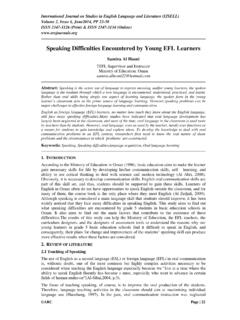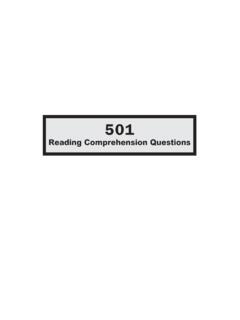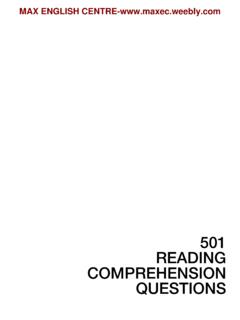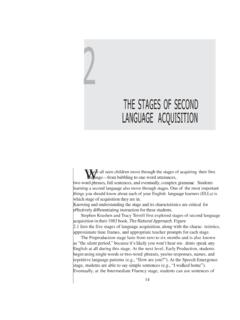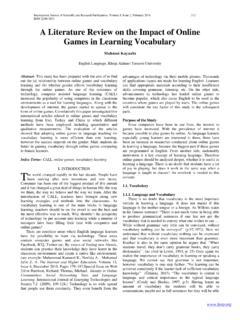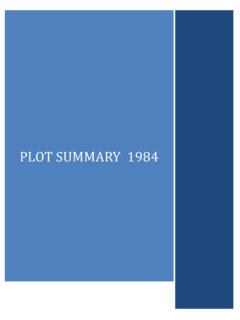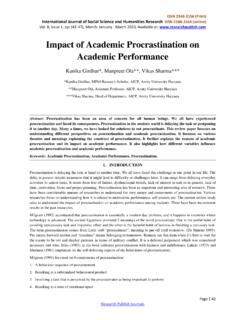Transcription of Implementation of Communicative Approach
1 English Language Teaching; Vol. 7, No. 8; 2014 ISSN 1916-4742 E-ISSN 1916-4750 Published by Canadian Center of Science and Education 68 Implementation of Communicative Approach Shazi Shah Jabeen1 1 BITS Pilani, Dubai Campus, Dubai, UAE Correspondence: Shazi Shah Jabeen, Department of Humanities and Social Sciences, BITS Pilani, Dubai Campus, Dubai International Academic City, Box 345055, Dubai, UAE. Tel: 971-4420-0700. E-mail: Received: May 20, 2014 Accepted: June 21, 2014 Online Published: July 15, 2014 URL: Abstract In the contemporary age of high professional requirements such as excellent Communicative skills, the need for successful learning of Communicative skills of English language suggests Communicative ability to be the goal of language teaching. In other words, to teach English language using Communicative Approach becomes essential.
2 Studies to measure teachers classroom behavior indicate that the Implementation of Communicative Approach in the classroom is rare. Although teachers claim to be following a Communicative Approach , in practice they seem to be following traditional approaches. The proposed study was undertaken to assess the existing situation with regard to the use of Communicative Approach in the teaching of English language at the secondary level in different schools of Delhi following the curriculum of Central Board of School Examination (CBSE), New Delhi. A Likert-type attitude scale was developed to understand the teachers attitudes towards the Communicative Approach . Keywords: classroom behaviour, Communicative , ESL, Implementation , language, teaching 1. Introduction In India English is no longer considered as a foreign language, rather as a second language. English language has deeply penetrated inside the various strata of the society.
3 It is no longer considered as a language learnt for communicating with its native speakers. Rather, it has become a key for professional success (Snow, Cortes, & Pron, 1998). The importance and status of English language cannot be over emphasized further today. In the Indian context one would assume that no Indian language could be an alternative to the English language in terms of importance and wide acceptability. One of the main reasons is that the English language is learnt not only for learning the language per se but its knowledge is used as a vehicle for other learnings. In the contemporary age of high professional requirements such as excellent Communicative skills, the pressure on the learners to develop their Communicative skills of English is rather imperative. The need for successful learning of Communicative skills of English language suggests Communicative ability to be the goal of language teaching.
4 In other words, to teach English language using Communicative Approach becomes essential. Communicative Approach is considered as the most effective theoretical model in English language teaching since early 1970s. The underlying concept of this Approach is that language carries not only functional meaning, it carries social meaning as well. So, it is not only important to learn the linguistic forms but also to understand their potential Communicative functions and social meanings. That is to say, the learners should be able to relate the linguistic forms to appropriate non-linguistic knowledge in order to interpret the specific functional meaning intended by the speaker (Littlewood, 1981). One of the most characteristic features of Communicative language teaching is that it pays systematic attention to functional as well as structural aspects of language, combining these units into a more fully Communicative view (Littlewood, 1981).
5 Communicative language teaching is based on Hymes s (1966) concept of Communicative competence which is an extension of Chomsky s (1965) concepts of linguistic competence and performance. Hymes pointed out that linguistic or grammatical competence alone is not enough to be able to use language in a given cultural social set up. Thus, the situation in which language has to be used becomes relevant for language teaching. He further emphasized that a normal child s acquisition of knowledge of sentences is not only grammatical but also appropriate because of Communicative competence (Hymes, 1972). It is important to mention here that Communicative language teaching is strongly associated with a number of English Language Teaching Vol. 7, No. 8; 2014 69 activities such as group work, pair work, open or cued dialogues, role playing, etc. These activities are called Communicative activities and are designed by the teachers to provide an opportunity for learners to use language that they have already learnt in different situations.
6 2. Literature Survey Many scholars like Littlewood (1981), Richards and Rodgers (2001) have attempted to identify characteristic features of Communicative language teaching. Several research works has been done in this direction that has led to the growth and expansion of Communicative language teaching. Besides, scholars like Guthrie (1984), Long and Sato (1983), Nunan (1987), Karavas (1996) have also carried out studies to understand the Implementation of Communicative Approach by teachers in a classroom situation. They have tried to measure teachers classroom behavior and the extent of the Implementation of Communicative Approach in their classrooms. Most of these studies indicate that the Implementation of Communicative Approach in the classroom is rare. The instructors seem to be following traditional approaches in their classrooms, contrary to their assertion of following a Communicative Approach .
7 The Communicative Approach has apparently brought innovation more on the level of theory than on the level of teachers actual classroom practices (Karavas, 1996). The present study is inspired as well as based on the work done by Karavas on Greek EFL classrooms (1996). According to Karavas, the classroom practices of the teachers who were observed (with very few exceptions) did not conform to the principles of the Communicative Approach . However, the disparities between teachers classroom behavior and their expressed attitudes have not been identified by this study only. As mentioned earlier, there are other studies also indicating the same type of disparity. 3. Objective of the Study The proposed study was selected with an objective to assess: 1) Attitude of the teachers towards Communicative Approach . 2) Existing gap, if any, between Communicative language teaching theories and their actual Implementation in the classroom.
8 3) Factors leading to the gap. 4. Methodology To meet the objectives of the study, a mix of pilot survey, sample survey, participant observation and interview was undertaken. Four different types of schools of Delhi following the curriculum of Central Board of School Examination (CBSE), New Delhi selected for the study was: 1) Government Schools (Run by State Government of Delhi) 2) Navyug Vidyalayas (Run by New Delhi Municipal Corporation, an autonomous body of Delhi) 3) Central Schools or Kendriya Vidyalayas (Run by Central Government of Delhi) 4) Private Schools of Delhi (Run by Private Organizations) The study focused on the degree of Implementation of Communicative Approach in the ESL classrooms at the secondary level (VI to X). This is because the teaching of the language using Communicative activities is supposed to be carried out mainly at this level. Whereas at the primary levels mostly the teaching of vocabulary and structure practice is to be done to feed the students the basic knowledge of the language first and then to enable them to participate later (at secondary level) in Communicative activities.
9 By the time the students reach tertiary level, which is an advanced level, they become well versed or fluent in the language. So, they do not need such activities any more. One significant point in reference is that CBSE offers two types of courses for English Language which are classified as Course A and Course B. Furthermore, the CBSE coursework (whether course A or course B) is common in all schools for classes IX and X. However, for lower classes (from Class I to VIII), the schools are free to have their own set of books from their own choice of publishers. The English language curriculum of the schools of Delhi and other places in India was revised by CBSE to incorporate Communicative language teaching. CBSE implemented Communicative language teaching in its Course A for English language at IX and X level from academic session 1993-94.
10 As a result the textbooks in various schools of India underwent significant changes to incorporate the Communicative Approach . The ultimate aim of the new curriculum and textbooks was to develop skills in reading, writing, listening and speaking and to English Language Teaching Vol. 7, No. 8; 2014 70 extend vocabulary to enable a student to enjoy and appreciate fiction, poetry and drama. It was hoped that the new course materials would instill a sense of confidence among students and heighten their proficiency in learning English as a second language. Under the new plans a series of textbooks which include a main course book , a literature reader, a workbook, long reading text and audio cassettes were introduced. The suggested exercises were to hold group discussions among students, planned projects etc. The board earnestly wished that all schools connected with the new course A adopted the new course plan.










